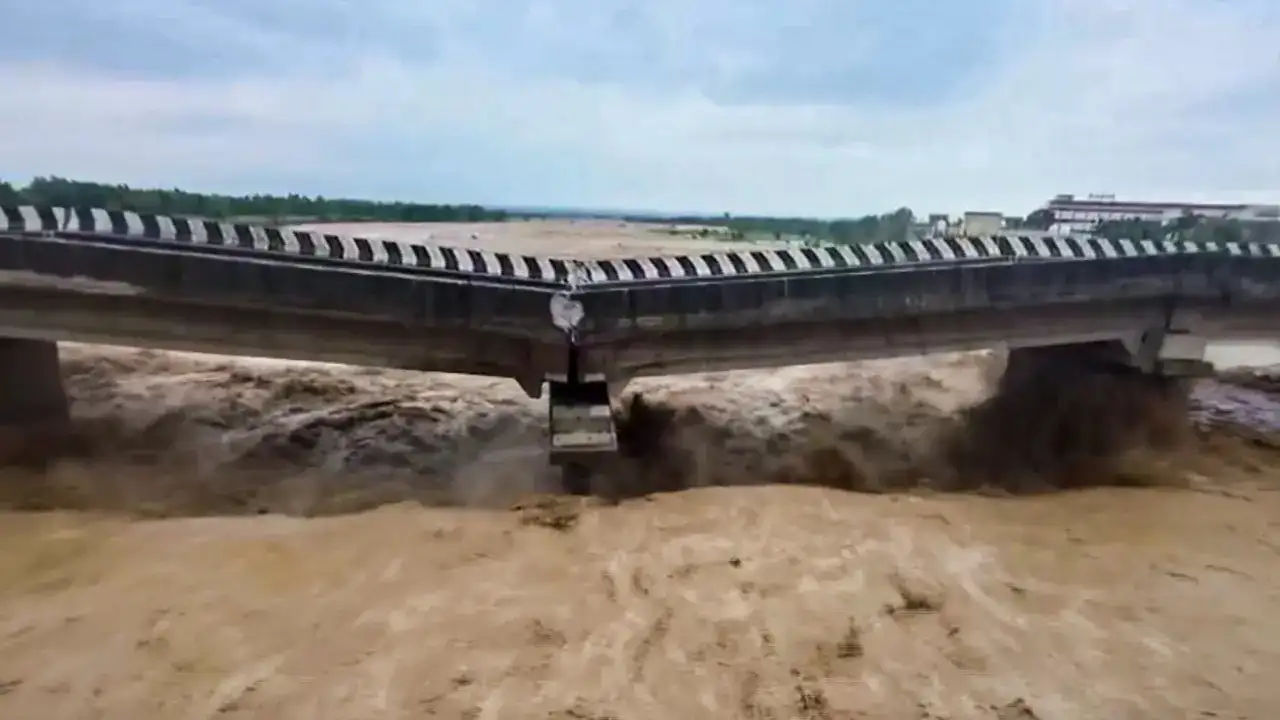Kathua Bridge Crumbles, Floods Ravage Jammu—Youth and Infrastructure Left Exposed
By: Javid Amin | 24 Aug 2025
When Rain Turns into Ruin
On August 24, 2025, Jammu recorded 190.4 mm of rainfall—the second-highest August downpour in a century.
What could have been remembered as a day of much-needed monsoon relief instead descended into chaos, fear, and destruction.
-
Bridges collapsed
-
Roads caved in
-
Hostels were submerged
-
Exams were postponed
From Kathua to Jammu city, the downpour exposed not only the fury of nature but also the fragility of man-made infrastructure.
The Collapse of Kathua’s Sahar Khad Bridge
The Sahar Khad bridge on the Jammu-Pathankot highway—an arterial route linking Jammu with Punjab—was among the first casualties.
-
Cause of collapse: Years of illegal sand and gravel mining had weakened the riverbed around the bridge’s pillars.
-
Impact: Floodwaters, already swollen from record rainfall, tore away soil around the foundation, leaving pillars hanging and exposed.
-
Aftermath: Traffic came to a halt. Vehicles piled up for miles. Authorities rushed to divert traffic, but narrow alternative routes soon collapsed under the weight of thousands of stranded commuters.
Local residents weren’t surprised.
“We warned them. Mining was eating away the river. The bridge was standing on air,” said a shopkeeper in Kathua.
The bridge wasn’t just infrastructure—it was a symbol of administrative neglect and how short-term exploitation undermines long-term safety.
Youth at Risk – The IIIM Jammu Hostel Rescue
As bridges crumbled, floodwaters invaded campuses.
At the Indian Institute of Integrative Medicine (IIIM) Jammu, nearly 45 students found themselves trapped inside their submerged hostel complex.
-
Rescue teams waded through waist-deep waters to pull them to safety.
-
Parents rushed frantically, blocked by waterlogged roads.
-
Students lost books, laptops, and essentials—an academic year disrupted.
This was not an isolated case—across Janipur, Roop Nagar, Talab Tilloo, Canal Road, homes, schools, and offices saw water surging through doorsteps.
The youth, already burdened with unemployment and paper-leak scandals, now faced flood trauma.
Schools Shut, Exams Postponed
On August 25, as conditions worsened, the administration ordered:
-
Closure of all schools in Jammu Division
-
Postponement of JKBOSE Class 10 and 11 exams
For students, this was more than inconvenience. It was a psychological blow.
-
After the JKSSB JE Electrical exam scandal, trust in institutions was already shaken.
-
Now, floods literally washed away their preparations.
Education, often seen as the ladder out of poverty in Jammu & Kashmir, found itself submerged alongside flooded classrooms.
A Pattern of Neglect
Was this just climate chaos, or something more? Experts argue it’s both.
-
Encroached Nallahs: Natural drainage channels turned into garbage dumps and illegal constructions.
-
Unregulated Mining: Rivers weakened, bridges destabilized.
-
Ignored Warnings: Meteorological alerts, environmental impact assessments, and civil engineers’ reports repeatedly brushed aside.
Every rainstorm becomes a disaster multiplier because the city and its outskirts are unprepared.
Environmentalists have warned for years that Jammu is turning into a “water trap”—urban expansion choking natural water pathways.
Climate Change – The Silent Multiplier
The Himalayas are among the regions most vulnerable to climate change.
-
Erratic Rainfall: Instead of long, steady monsoons, we now see short, intense cloudbursts.
-
Increased Flood Risk: Warming air holds more moisture, releasing it violently.
-
Urban Heat Islands: Concrete-heavy cities like Jammu reduce absorption, turning rain into runoff.
The 190.4 mm rainfall was not just a natural extreme—it was climate change meeting bad planning.
Infrastructure in Question
The Kathua bridge collapse and flooded roads highlight a deeper crisis: Jammu’s infrastructure is outdated and fragile.
-
Bridges built decades ago are never retrofitted for today’s climate intensity.
-
Drainage systems clogged by construction waste collapse every monsoon.
-
Highways widened by blasting weaken slopes, leading to landslides.
Development has been pursued at speed, but safety and sustainability lag behind.
Voices from the Ground
-
A college student: “We studied for months, and now our exams are postponed again. It feels like our future is sinking with the floods.”
-
A truck driver stranded at Kathua: “I have perishable goods. Every hour I’m stuck, I lose money.”
-
A resident of Roop Nagar: “Every year we raise the plinth of our home, and every year the water rises higher.”
The floods are not just an administrative problem—they are a human crisis.
The Way Forward – Can Jammu Learn?
Disasters can be opportunities for course correction. Experts suggest:
-
Ban illegal mining around rivers and bridges.
-
Redesign urban drainage with climate resilience in mind.
-
Strengthen disaster management: real-time weather alerts, pre-flood evacuation drills.
-
Retrofit old infrastructure: ensure bridges and roads can withstand heavy floods.
-
Educate communities: awareness programs on waste disposal, safe construction, and flood zones.
The question is whether these lessons will be implemented—or forgotten until the next downpour.
FAQs: Jammu Floods 2025
Q1. Why did the Kathua bridge collapse?
Because of years of illegal mining weakening its pillars and sudden pressure from record rainfall.
Q2. How much rainfall did Jammu receive?
190.4 mm on August 24, 2025—the second-highest August rainfall in 100 years.
Q3. Were students affected?
Yes. 45 students at IIIM Jammu were rescued, and schools across the division were closed with exams postponed.
Q4. Is this linked to climate change?
Yes—climate change intensified rainfall, but weak planning and unregulated construction turned it into disaster.
Conclusion: A Wake-Up Call
The Jammu floods of August 2025 were not just about heavy rain. They were about bridges weakened by greed, drains blocked by neglect, and communities abandoned by poor planning.
Nature may unleash fury, but it is human decisions that decide the scale of destruction.
Unless Jammu & Kashmir embraces climate-resilient development, today’s floods will be tomorrow’s routine.



